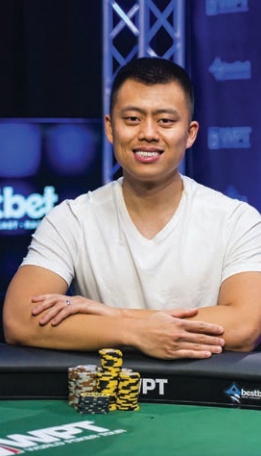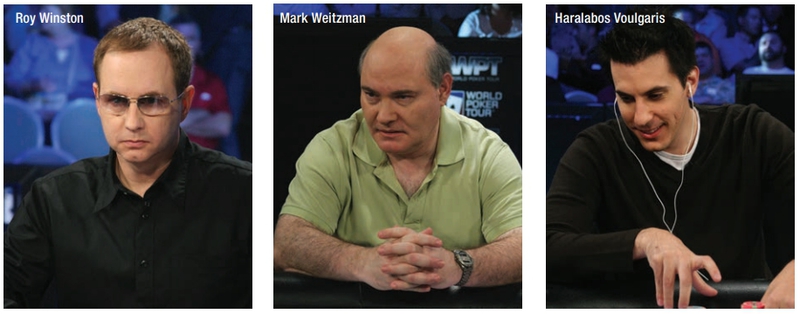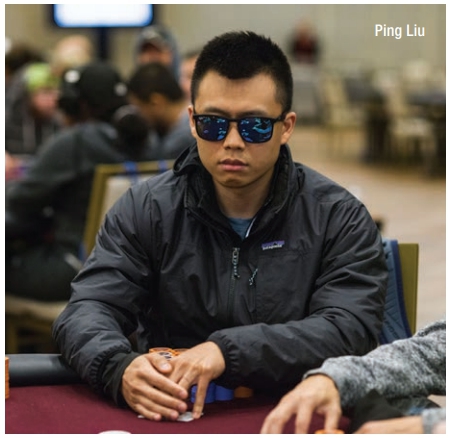






Shifts In Poker Strategy With Ping LiuPoker Pros Revisit Hands From The Past To Show How The Game Has Changed |
|
|
 In the nearly two decades since poker experienced a boom thanks to Chris Moneymaker’s historic World Series of Poker main event victory in 2003, the strategy surrounding the game has evolved at a pace never before seen. With online poker, the game’s best players were able to see more hands quickly and develop more complex strategies to win. Bet sizing, aggression levels, and even something as basic as preflop hand selection has changed drastically since the game went mainstream.
In the nearly two decades since poker experienced a boom thanks to Chris Moneymaker’s historic World Series of Poker main event victory in 2003, the strategy surrounding the game has evolved at a pace never before seen. With online poker, the game’s best players were able to see more hands quickly and develop more complex strategies to win. Bet sizing, aggression levels, and even something as basic as preflop hand selection has changed drastically since the game went mainstream.
Chicago native and Southern California resident Ping Liu has been playing long enough to see most of these changes. With his first significant cash as a pro coming back in 2011 and experience playing online before that, Liu emerged as a true force in 2018 as a contender for the World Poker Tour Player of the Year title. Not only did he finish fourth in the Five Diamond World Poker Classic for $599,147, but he also took fourth in the Rolling Thunder main event for another $97,510, and fifth in the bestbet Bounty Scramble for another $73,734.
Last year, Liu picked up a win at the LA Poker Classic, while also final tabling the $10,000 super turbo bounty event at the WSOP and finishing third in the WSOP Circuit Planet Hollywood main event. He now has $2.1 million in career tournament earnings, and is currently accepting students for poker coaching and can found on Twitter @PingDotCom.
Liu sat down with Card Player to break down a couple hands from the 2007 WPT Borgata Poker Open main event final table, which featured Mike Matusow, Eugene Todd, Mark Weitzman, Haralabos Voulgaris, and eventual winner Roy Winston.
The Action: Roy Winston raised to 230,000 on the button and Mark Weitzman called out of the big blind. On the flop, Weitzman led out for 400,000 and Winston raised to 1,400,000. Weitzman folded.

Steve Schult: Before we even get into the hand itself, the first thing I noticed is the ante size. The blinds are 40,000-80,000, but the ante is just 5,000, meaning there is 30,000 in the middle in antes at the six-handed final table. Nearly all poker tournaments now use the big blind ante, which would put 80,000 in antes in the middle. So how should the ante size dictate your preflop hand selection?
Ping Liu: It’s pretty simple, intuitively, that if there is less dead money in the pot preflop, then you have less to win by raising and trying to steal the blinds. Therefore, you are less incentivized to voluntarily put money in the pot, and because of that, you will be opening slightly tighter ranges.
SS: Should it affect how large or small you raise? In this hand, Winston raises on the button to 230,000 and nowadays you would see something between 160,000 and 200,000 in this spot.
PL: If there is less money in the middle, your raise size should go down as well. If there is less in the middle, and you’re still raising three times the blind, you’re risking more to win less. So, it’s kind of similar preflop where you can just think of what you’re raising by a percentage of the pot.
Let’s say you were in a cash game and the blinds were $1-$2 and you’re raising 2.5 big blinds to $5. That is 62.5% of the pot. And obviously with more dead money in the middle, 60% of the pot gets bigger and bigger effectively. The bigger the antes, the more you should be raising preflop, because you stand to win more if you take the blinds down right away.
That being said, back in the day, people really did raise close to 3x as the standard and I’m not really sure why that was. And I think over the years, preflop raise sizes just started getting smaller and smaller all the way down to just a min-raise, which I think started happening around 2014.
SS: Winston raises to 230,000 and Mark Weitzman calls out of the big blind. Weitzman started the hand with 1.75 million, or about 23 big blinds. I remember a mantra from this time period with regard to stack sizes which generally said that with around 10 big blinds you should be open-shoving and with about 20, you should find spots to just three-bet shove your stack. Should Weitzman have much of a flatting range?

PL: The first thing is that you’re right that 13 years ago, people usually played 20-big blind stacks a lot more like you described. They would just shove over an open. But over the years, [we have realized] there is still a lot more play anywhere between 10- and 20-big blind stacks. You can flat and take your hand post-flop.
But that is also a function of what we were talking about before. If someone is min-raising, and you have 20 big blinds in the big blind, you can still defend and have a decent amount of playability. But when people are opening to 3x, and now you have to call two additional big blinds instead of one, it does make a big difference.
Once they start tripling the blind, your risk/reward for just shoving becomes a lot better. If they fold pre to your jam, you’re going to win another big blind plus what’s in the middle. I think there has been more play post-flop recently at the shorter stack sizes, but that’s also a function of the raise sizes preflop going down.
SS: Weitzman calls and the flop comes jack-high with two clubs. He then donk-bets (betting from out of position into the aggressor) for 400,000. Can you explain the rationale of why you would want to donk-bet?
PL: The rationale behind donk-betting is that you connected with that particular flop stronger than your opponent did. You’re saying that you have the range advantage on that board. Usually, if someone is the preflop raiser, you are going to have the strongest hands in your range. You’ll have A-A, K-K, Q-Q, A-K. And if you just flat the raise preflop, then those hands aren’t going to be present in your range because you most likely would’ve put in a three-bet.
So very often, the player who defends from the big blind, won’t have a big hand. Because the top of their range isn’t going to be present. There are certain, pretty specific board textures, where the big blind theoretically could have a range advantage, but those are going to be on the lower board textures.
Something like 4-5-6 with a flush draw. That’s a board where it is more theoretically optimal to construct a donk-leading range out of the big blind, because you’ll have a lot more of the 4-5’s, the 4-6’s, the 5-6’s, and also more straight combos than the button. The button probably isn’t raising 4-6 offsuit, but from the big blind, you could defend it.
In terms of what I actually think he’s doing here, I would guess that he just has a hand that he is looking to go with at this point. He’s just trying to protect it and take the pot down right away.
SS: How have you seen the donk-bet strategy change throughout the years? Is there more or less of it now than when you started posting results a decade ago?
PL: I do think the amount of donk-betting has gone down over the years quite substantially. Most moderately studied players know that when you defend out of the big blind, the most common play is to check to the preflop raiser and then react accordingly.
 That’s something that all the solvers have proven. Checking your range is going to be the best play. Back then in the pre-solver era, people didn’t understand how ranges interacted and they just started donking on boards where they shouldn’t have a leading range on it.
That’s something that all the solvers have proven. Checking your range is going to be the best play. Back then in the pre-solver era, people didn’t understand how ranges interacted and they just started donking on boards where they shouldn’t have a leading range on it.
The main problem with doing that is it turns your hand face up. Let’s say you’re playing with a relatively weak player and they donk on this board and you have nothing, so you just fold. Then the next time you play a hand with them and you get a similar board texture, and now they check. Because you know they have a donking range and they put their strong hands in it, their checking range becomes unprotected. Every time they check, you can just c-bet (continuation bet) everything and expect to get a lot of folds because their range will be significantly weaker.
SS: Weitzman had 14 big blinds behind, and there was another player with about 18 big blinds. Is this a good spot for Winston to apply ICM (Independent Chip Model) pressure or does he usually have a hand here?
PL: I think he has to have some equity. He can’t just do it with air because I think the big blind is showing a significant amount of strength by donking so big on this board without much behind. He shouldn’t expect him to lead this big and fold. More likely than not, he’s got a strong top pair.
The Action: The action folded to Haralbos Voulgaris, who completed the small blind. Weitzman checked his option from the big blind. Both players checked the flop and Voulgaris bet 155,000 on the turn. Weitzman called. Both players checked the river and Weitzman won the pot at showdown.

SS: Action folds to Haralabos in the small blind, who completes. Open limping is still somewhat prevalent in today’s game, but what were the types of hands you would generally see people limp with?
PL: Open limping is definitely part of a pretty viable preflop strategy, even in 2020. And you’re going to see it a lot more once you get to a sub-20 big blind stack depth. You can have some open limps from the cutoff with like 15 big blinds or so. And the same thing for the button.
But specifically, in this spot, blind vs. blind, the optimal strategy does include a lot of limps from the small blind. Especially with an ante in the pot, the small blind is getting such a good immediate price to complete, they really are going to be incentivized to play a lot of their hands. And because their ranges are going to be so wide, often times, the small blind will often play a limp-only strategy and then respond accordingly if the big blind does choose to raise.
SS: Weitzman checks his option and the flop is A-K-J with two hearts. Both players check and the 9 comes on the turn. Voulgaris decides to take a pot-sized stab with his deuces. I remember a limp-stab strategy being implemented in these spots. Is this just a delayed limp-stab?
comes on the turn. Voulgaris decides to take a pot-sized stab with his deuces. I remember a limp-stab strategy being implemented in these spots. Is this just a delayed limp-stab?
PL: With deuces, nowadays, the standard play preflop would be just to shove when the big blind has 20 big blinds and you cover him. The low pocket pairs don’t play particularly well post-flop, especially against the big blind.
As played, most players would take a stab right away with deuces on the flop. On an A-K-J board texture, when the big blind checks back, he is going to be really capped and not have any of the strong hands in his range. Those are the hands he would’ve raised or shoved preflop.
It’s unlikely that the big blind has an ace in his hand, whereas the small blind can still have some of the stronger hands in his range that was going for a limp-raise. It’s a better board texture for the small blind, so I think the better play would be to stab the flop. Even just for one big blind would be fine. If the big blind has two unders, they aren’t going to continue regardless of what size he chooses.
When we get to the turn, he’s probably thinking the same thing. The big blind probably doesn’t have that much, and he’s just going to bet his hand and deny some equity. I think the pot-sizing is not super effective. What he’s trying to get him to do is get him to fold an air hand, win the pot right away, and protect his low pair. But since the pot is slightly more than two big blinds, then all he needs to do is bet the minimum.
The big blind will fold something like 7-5 offsuit, or whatever rags he has. And if the big blind does have a pair, he won’t fold regardless of whether Haralabos bet one big blind or full pot.
SS: I know you’re speculating here, but do you think Haralabos was planning to limp-shove on Weitzman preflop?
PL: I think it should just be a shove every time, so I’m not sure. From the small blind, there is a lot more limping, but the deeper you are, with more antes in the middle, the more you should play a limp-only strategy because you’re going to be playing out of position and deep-stacked.
The shorter and shorter you get, the more open raising or open shoving you are going to see. At the 20-big blind stack depth, there is a significant portion of your range that is going to want to open shove preflop, and the most prevalent part of that range is going to be the small pocket pairs and low, offsuit aces that don’t play well post-flop. And even some low suited aces could shove preflop. You could shove some suited connectors for balance. He will have some limping in his range and will have raise-calls in his range and some raise-folds. The shallower you get, the more options you want to have from the small blind.
SS: Weitzman actually had Q-J offsuit. Should he be raising? What do you think about his option check preflop?
PL: Did you say he was the shortest stack at this point?
SS: At this point, he is the second-shortest stack. There was one player at the table who had about seven big blinds.
PL: Given that there is a significant amount of ICM consideration because he’s going to get a pretty big pay jump if he just folds and lets the other guy bust, that would make me want to check back his hand a little bit more often.
He could just shove over the limp. And if he knows that Haralabos is going to limp something like 2-2, then I really like shoving as well, because you’re probably going to get him to fold some stuff that he shouldn’t. I think his two options are either to check back or shove.
I don’t think raising is a good strategy because I think there is a portion of Haralabos’ range that will be limp-shoving, and I think 2-2 would be part of that range. You don’t want to raise something like 3x and then face a shove.
SS: Weitzman called the turn bet and both players checked the river.
PL: I think the river action is pretty standard at this point, but it just sort of goes back to what I said about the turn. Haralabos didn’t need to bet so big on the turn because he would’ve accomplished what he was trying to with a one big blind bet. When he does bet turn and check river, it does seem like his plan was to just take the pot down right away. Weitzman played his hand totally fine.
 The Result: Weitzman finished fourth, taking home a payday worth $380,240. Voulgaris was able to outlast him by one spot, earning $434,560 for third place. It was also just one spot shy of Voulgaris’ career best, when he finished runner up in the 2005 WPT LA Poker Classic main event.
The Result: Weitzman finished fourth, taking home a payday worth $380,240. Voulgaris was able to outlast him by one spot, earning $434,560 for third place. It was also just one spot shy of Voulgaris’ career best, when he finished runner up in the 2005 WPT LA Poker Classic main event.
Winston went on to win the tournament and secure the $1,575,280 first-place prize. The doctor-turned-poker-enthusiast made a deep run in that year’s WSOP main event, finishing 26th for $333,490, and also won a preliminary event at the Five Diamond World Poker Classic for another $230,365, but mostly abandoned the tournament circuit after 2010. ♠
